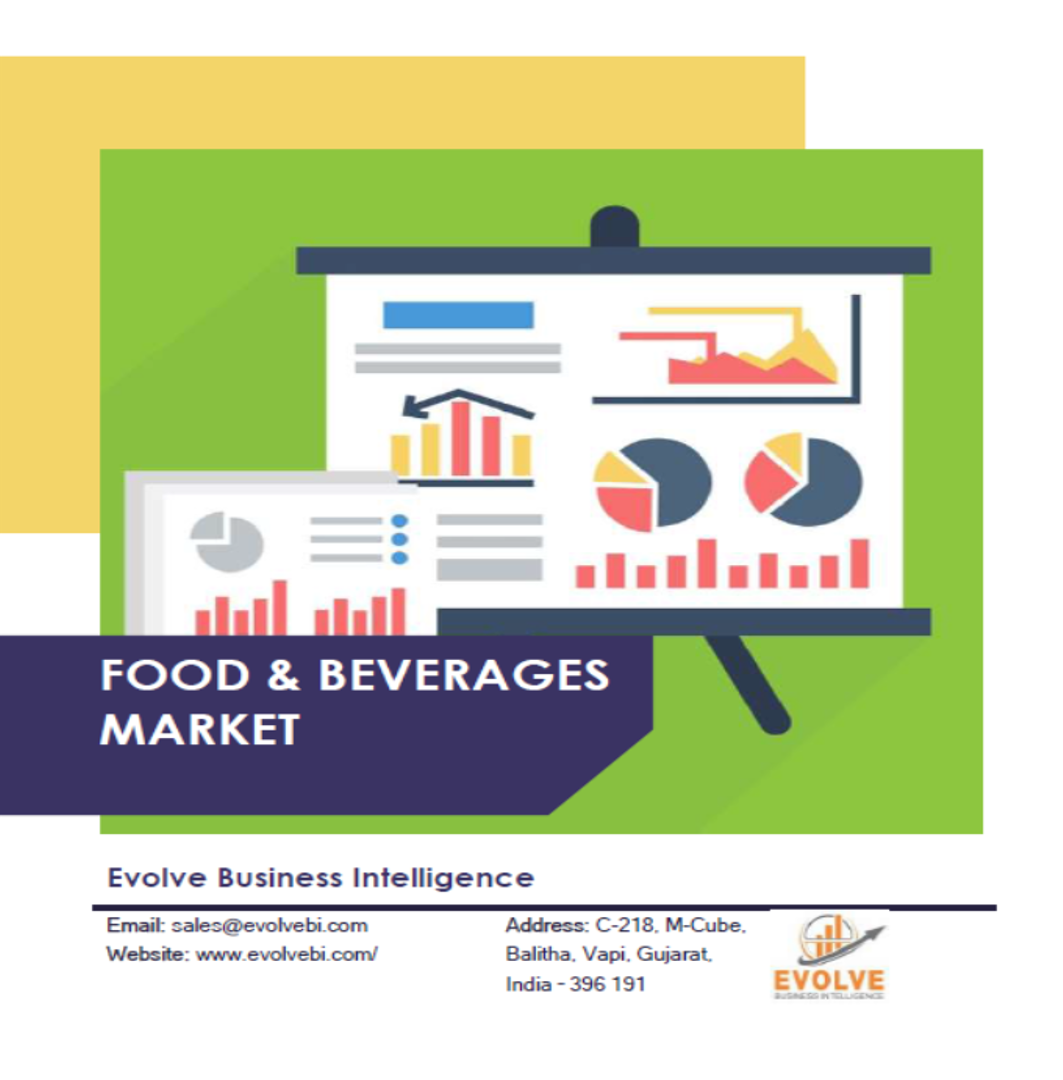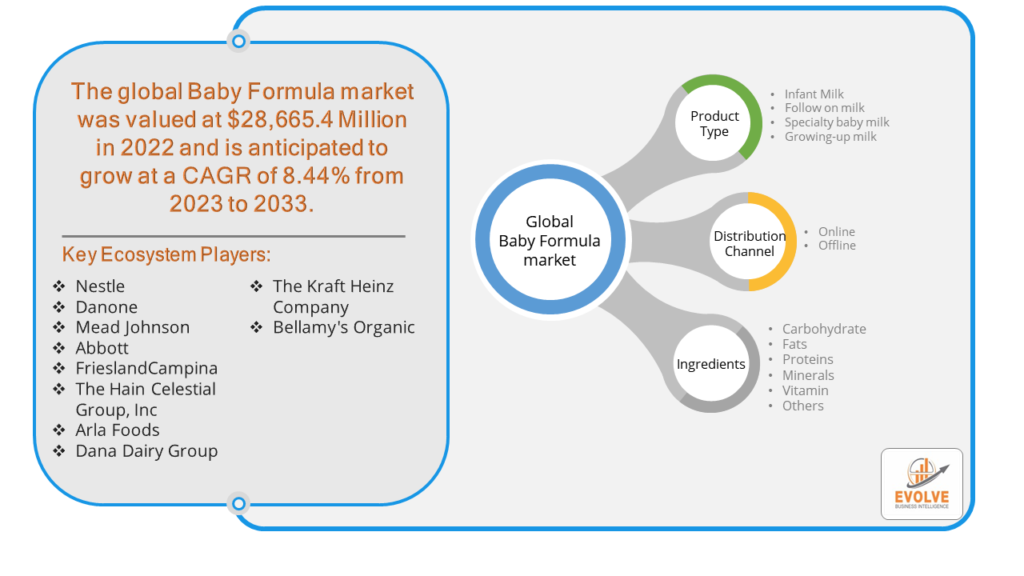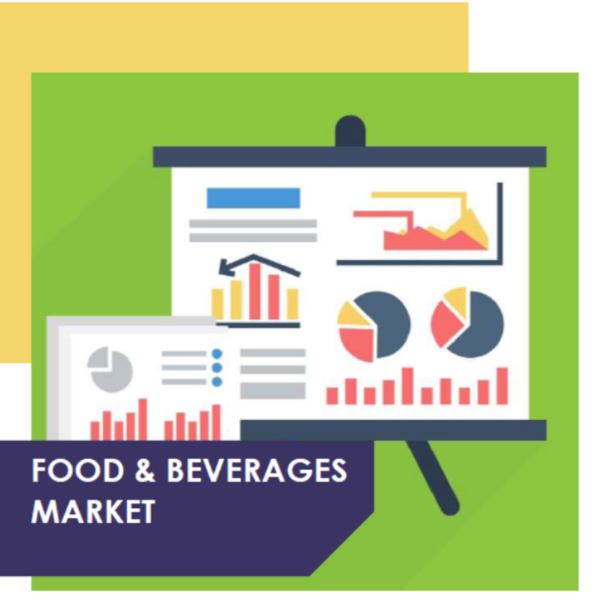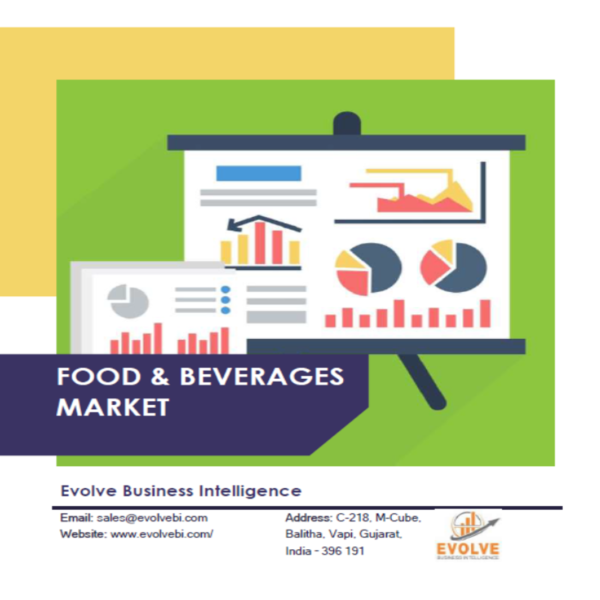Baby Formula Market Analysis and Global Forecast 2023-2033
$1,390.00 – $5,520.00Price range: $1,390.00 through $5,520.00
Baby Formula Market Analysis Research Report: Information By Product Type (Infant Milk, Follow on milk, Specialty baby milk, and Growing-up milk), By Ingredient (Carbohydrate, Fats, Proteins, Minerals, Vitamin), By Distribution Channel (Online and Offline), and by Region — Forecast till 2033
Page: 174
[vc_row][vc_column width=”2/3″][vc_column_text text_larger=”no” woodmart_inline=”no”]
Baby Formula Market Analysis Overview
The Baby Formula Market Analysis Size is expected to reach USD 71.79 Billion by 2033. The Baby Formula Market Analysis industry size accounted for USD 31.92 Billion in 2023 and is expected to expand at a compound annual growth rate (CAGR) of 8.44% from 2023 to 2033. A baby formula market analysis examines the trends, factors, and statistics that influence the buying and selling of infant formula. It’s basically a deep dive into this specific market sector. This involves estimating the total revenue of the baby formula market globally and regionally, along with its projected growth rate over a specific period.
This section explores the factors that are causing the market to grow. It could include rising birth rates in certain regions, increasing disposable income of parents, or a growing preference for convenience foods for babies. The analysis would identify factors that might hinder the market’s growth, such as supply chain disruptions, safety concerns with certain formulas, or government regulations.
A baby formula market analysis helps companies understand the current and future potential of this market. This knowledge can be used to make informed decisions about product development, marketing strategies, and even potential investments.
Global Baby Formula Market Analysis Synopsis
The COVID-19 pandemic had significant impacts on the baby formula market. Lockdowns and restrictions affected production facilities, leading to reduced manufacturing capacity. Transportation restrictions and border closures disrupted the supply chain, causing delays and shortages in some regions. Sourcing of essential raw materials became difficult, impacting the production process. Initial stages of the pandemic saw a surge in demand due to panic buying and stockpiling by parents, leading to temporary shortages. With physical stores facing closures or reduced hours, there was a significant increase in online purchases of baby formula. Parents became more health-conscious, leading to a preference for high-quality and fortified baby formula products. Economic uncertainty and reduced household incomes affected purchasing power, influencing buying decisions. Price became a more critical factor for many consumers, with some opting for more affordable options.
Baby Formula Market Analysis Dynamics
The major factors that have impacted the growth of Baby Formula Market Analysis are as follows:
Drivers:
Ø Increasing Birth Rate and Population Growth
Higher birth rates in certain regions contribute to increased demand for baby formula. Urban areas often see higher birth rates and a greater reliance on baby formula due to busy lifestyles. Initiatives by governments and health organizations to educate parents about the importance of proper infant nutrition. Modern parents are more knowledgeable about the nutritional needs of their infants, leading to increased demand for high-quality baby formula. More women joining the workforce creates a need for convenient feeding options, boosting the demand for baby formula. Inadequate maternity leave policies in some regions necessitate the use of baby formula. Economic growth and rising disposable incomes in developing countries lead to higher spending on premium baby products. Parents are more willing to invest in high-quality nutrition for their infants.
Restraint:
- Perception of Breastfeeding Promotion and Initiatives
Many governments and health organizations strongly promote breastfeeding as the best source of nutrition for infants, which can reduce the demand for baby formula. Increased awareness and advocacy for breastfeeding through public health campaigns can sway parents away from using formula. The baby formula industry is subject to rigorous regulations regarding product safety, labeling, and marketing, which can be costly and time-consuming for manufacturers to comply with. Meeting these regulatory standards often involves significant investment in research, quality control, and certification processes.
Opportunity:
⮚ Product Innovation and Differentiation
Development of specialized formulas catering to specific health needs, such as hypoallergenic, lactose-free, organic, and formulas fortified with probiotics and prebiotics. Innovations in production technology to enhance the nutritional profile, taste, and digestibility of baby formula. Increasing consumer awareness about health and wellness is driving demand for organic and natural baby formulas. Products with clean labels that are free from artificial additives, preservatives, and GMOs are becoming more popular among health-conscious parents. Investing in sustainable and recyclable packaging options to appeal to environmentally conscious consumers. Ensuring that raw materials are sourced sustainably to improve brand image and meet consumer demand for eco-friendly products.
Baby Formula Market Analysis Segment Overview
By Product Type
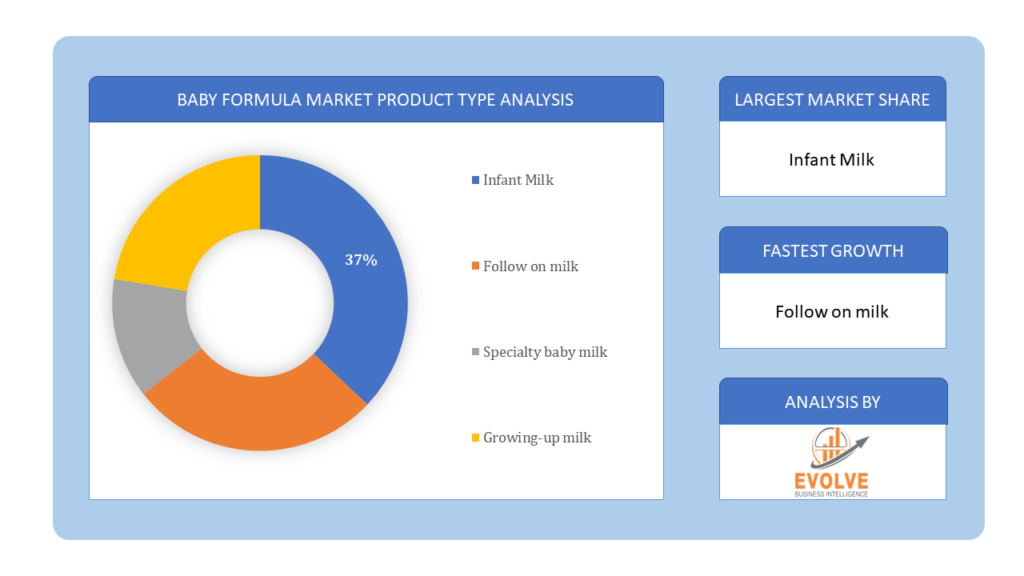 Based on Product Type, the market is segmented based on Infant Milk, Follow on milk, Specialty baby milk and Growing-up milk. The infant milk segment accounted for a major baby infant formula market. Infant milk is specially designed to meet the growing needs of babies under six months of age, who are not breastfed or partially breastfed. Lack of acceptable alternatives as only breast milk is a viable substitute for infant milk and increase in infant population in India, China, Indonesia, Philippines, Brazil and other emerging countries are expected augment the demand for infant milk segment in baby infant formula market.
Based on Product Type, the market is segmented based on Infant Milk, Follow on milk, Specialty baby milk and Growing-up milk. The infant milk segment accounted for a major baby infant formula market. Infant milk is specially designed to meet the growing needs of babies under six months of age, who are not breastfed or partially breastfed. Lack of acceptable alternatives as only breast milk is a viable substitute for infant milk and increase in infant population in India, China, Indonesia, Philippines, Brazil and other emerging countries are expected augment the demand for infant milk segment in baby infant formula market.
By Ingredient
Based on Ingredient, the market segment has been divided into the Carbohydrate, Fats, Proteins, Minerals and Vitamin. The carbohydrate segment dominant the market. Carbohydrates are an important source of energy for growing infants, as they account for almost 40% of their daily energy intake. In most cow milk-based formulas, lactose is the main source of carbohydrates. Lactose may benefit the gut microbiota and help in absorption of calcium. Thus, such benefits of carbohydrates drive the growth of the overall market globally.
By Distribution Channel
Based on Distribution Channel, the market segment has been divided into the Online and Offline. The offline segment is dominant the market. Manufacturers consistently work to improve their products’ shelf visibility; as a result, they focus mostly on offline sales. As a result, a larger selection of food items, including baby food, are offered offline. In addition, since the bulk of products are bought in offline stores and brand preference is easier to acquire in rural areas of developing countries, the offline market is crucial for customers living there. As a result, these elements are promoting market expansion.
Global Baby Formula Market Analysis Regional Analysis
Based on region, the global Baby Formula Market Analysis has been divided into North America, Europe, Asia-Pacific, the Middle East & Africa, and Latin America. North America is projected to dominate the use of the Baby Formula Market Analysis followed by the Asia-Pacific and Europe regions.
Baby Formula North America Market
North America holds a dominant position in the Baby Formula Market Analysis. North America has High market penetration due to well-established healthcare infrastructure. Strong presence of leading brands and high consumer awareness. It drives High disposable incomes allowing for the purchase of premium products. Growing awareness of infant nutrition and preference for organic and specialty formulas.
Baby Formula Asia-Pacific Market
The Asia-Pacific region has indeed emerged as the fastest-growing market for the Baby Formula Market Analysis industry. Asia Pacific region currently holds the biggest market share, with countries like China and India being major players. The growth rate here is projected to be the highest due to factors like rising disposable income, increasing awareness of health benefits of formula, and a growing population. It drives Increasing birth rates and large infant population. Rising disposable incomes and growing middle class. Urbanization driving demand for convenient feeding options.
Competitive Landscape
The global Baby Formula Market Analysis is highly competitive, with numerous players offering a wide range of software solutions. The competitive landscape is characterized by the presence of established companies, as well as emerging startups and niche players. To increase their market position and attract a wide consumer base, the businesses are employing various strategies, such as product launches, and strategic alliances.
Prominent Players:
- Dana Dairy Group Ltd
- Arla Foods Amba
- Campbell Soups
- Danone
- D-Signstore
- HiPP GmbH & Co. Vertrieb KG
- Reckitt Benckiser
- The Hain Celestial Group
- Nestle S.A.
- Abbott
Key Development
In July 2023, Danone has launched the new Dairy & Plants Blend baby formula to meet parents’ desire for feeding options suitable for vegetarian, flexitarian and plant-based diets, while still meeting their baby’s specific nutritional requirements. It is the industry’s first blended baby formula for healthy babies, in which more than half (60%) of the protein comes from plants. Scope of the Report
Global Baby Formula Market Analysis, by Product Type
- Infant Milk
- Follow on milk
- Specialty baby milk
- Growing-up milk
Global Baby Formula Market Analysis, by Ingredient
- Carbohydrate
- Fats
- Proteins
- Minerals
- Vitamin
Global Baby Formula Market Analysis, by Distribution Channel
- Online
- Offline
Global Baby Formula Market Analysis, by Region
- North America
- US
- Canada
- Mexico
- Europe
- UK
- Germany
- France
- Italy
- Spain
- Benelux
- Nordic
- Rest of Europe
- Asia Pacific
- China
- Japan
- South Korea
- Indonesia
- Austalia
- Malaysia
- India
- Rest of Asia Pacific-
- South America
- Brazil
- Argentina
- Rest of South America
- Middle East & Africa
- Saudi Arabia
- UAE
- Egypt
- South Africa
- Rest of Middle East & Africa
| Parameters | Indicators |
|---|---|
| Market Size | 2033: $71.79 Billion |
| CAGR | 8.44% CAGR (2023-2033) |
| Base year | 2022 |
| Forecast Period | 2023-2033 |
| Historical Data | 2021 |
| Report Coverage | Revenue Forecast, Competitive Landscape, Growth Factors, and Trends |
| Key Segmentations | Product Type, Ingredient |
| Geographies Covered | North America, Europe, Asia-Pacific, Latin America, Middle East, Africa |
| Key Vendors | Dana Dairy Group Ltd, Arla Foods Amba, Campbell Soups, Danone, D-Signstore, HiPP GmbH & Co. Vertrieb KG, Reckitt Benckiser, The Hain Celestial Group, Nestle S.A. and Abbott. |
| Key Market Opportunities | • Product Innovation and Differentiation • Sustainability Initiatives |
| Key Market Drivers | • Increasing Birth Rate and Population Growth • Increase in Working Mothers |
REPORT CONTENT BRIEF:
- High-level analysis of the current and future Baby Formula Market Analysis trends and opportunities
- Detailed analysis of current market drivers, restraining factors, and opportunities in the future
- Baby Formula Market Analysis historical market size for the year 2021, and forecast from 2023 to 2033
- Baby Formula Market Analysis share analysis at each product level
- Competitor analysis with detailed insight into its product segment, Government & Defense strength, and strategies adopted.
- Identifies key strategies adopted including product launches and developments, mergers and acquisitions, joint ventures, collaborations, and partnerships as well as funding taken and investment done, among others.
- To identify and understand the various factors involved in the global Baby Formula Market Analysis affected by the pandemic
- To provide a detailed insight into the major companies operating in the market. The profiling will include the Government & Defense health of the company’s past 2-3 years with segmental and regional revenue breakup, product offering, recent developments, SWOT analysis, and key strategies.
[/vc_column_text][/vc_column][vc_column width=”1/3″][vc_column_text text_larger=”no” woodmart_inline=”no”][html_block id=”3961″][/vc_column_text][vc_wp_text]
Press Release
[rpwe limit=”10″ thumb=”true”][/vc_wp_text][/vc_column][/vc_row][vc_row][vc_column][vc_column_text woodmart_inline=”no” text_larger=”no”]
Frequently Asked Questions (FAQ)
[/vc_column_text][vc_column_text woodmart_inline=”no” text_larger=”no”][sp_easyaccordion id=”13353″][/vc_column_text][/vc_column][/vc_row]

